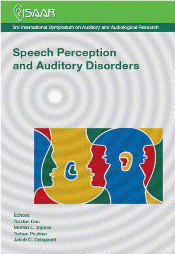Measuring speech-in-speech intelligibility with target location uncertainty
Abstract
The most common speech-intelligibility tests do only to a limited extent reflect the situations where hearing-impaired people typically experience speech-intelligibility problems in their everyday life. One major problem is that the resulting speech reception threshold (SRT) typically is unrealistically low. In an attempt to increase the ecological validity of the Danish Dantale II speech-intelligibility test, a modified version of the test was developed. The new version includes speech masking and target location uncertainty as ways to increase the resemblance to real-life situations. In the present study, test results were obtained from 16 hearing- impaired listeners and comparison was made to results obtained in three other test conditions, all having a fixed target position but including different types of masking signals. The results showed that the introduction of speech masking as well as target location uncertainty contributed to an increase in SRT.
References
Brungart, D.S. and Simpson, B. D. (2007) “Cocktail party listening in a dynamic multitalker environment” Percept. Psychophys., 69, 79-91.
Dreschler, W. A., Verschuure, H., Ludvigsen, C., and Westermann S. (2001): “ICRA noises: Artificial noise signals with speech-like spectral and temporal properties for hearing instrument assessment” Audiology, 40, 148-57.
Festen J. and Plomp R. (1990). “Effects of fluctuating noise and interfering speech on the speech-reception threshold for impaired and normal hearing” J. Acoust. Soc. Am., 88, 1725-36.
Francart, T., van Wieringen, A., and Wouters, J. (2011). “Comparison of fluctuating maskers for speech recognition tests” Int. J. Audiol., 50, 2-13.
Hagerman B. and Kinnefors C. (1995). “Efficient adaptive methods for measuring speech reception threshold in quiet and in noise” Scand. Audiol., 24, 71-77. Helfer, K. S. and Freyman, R. L. (2008). “Aging and Speech-on-Speech Masking” Ear Hear., 29, 87-98.
Kidd, G., Jr., Arbogast T. L., Mason, C. R., and Gallun F. J. (2005). “The advantage of knowing where to listen” J. Acoust. Soc. Am., 118, 3804-15.
Singh, G., Pichora-Fuller, M. K., and Schneider, B. A. (2008). “The effect of age on auditory spatial attention in conditions of real and simulated spatial separation” J. Acoust. Soc. Am., 124, 1294-1305.
Wagener, K., Josvassen, J. L., and Ardenkjaer, R. (2003). ”Design, optimization and evaluation of a Danish sentence test in noise” Int. J. Audiol., 42, 10-17
Additional Files
Published
How to Cite
Issue
Section
License
Authors who publish with this journal agree to the following terms:
a. Authors retain copyright* and grant the journal right of first publication with the work simultaneously licensed under a Creative Commons Attribution License that allows others to share the work with an acknowledgement of the work's authorship and initial publication in this journal.
b. Authors are able to enter into separate, additional contractual arrangements for the non-exclusive distribution of the journal's published version of the work (e.g., post it to an institutional repository or publish it in a book), with an acknowledgement of its initial publication in this journal.
c. Authors are permitted and encouraged to post their work online (e.g., in institutional repositories or on their website) prior to and during the submission process, as it can lead to productive exchanges, as well as earlier and greater citation of published work (See The Effect of Open Access).
*From the 2017 issue onward. The Danavox Jubilee Foundation owns the copyright of all articles published in the 1969-2015 issues. However, authors are still allowed to share the work with an acknowledgement of the work's authorship and initial publication in this journal.


